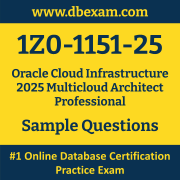01. How are resources provisioned in Oracle Database@Azure service?
a) Oracle Exadata Infrastructure and Oracle Exadata VM Cluster are provisioned in the Azure portal.
b) Oracle Exadata VM Cluster and Oracle container databases are provisioned in the OCI console.
c) Oracle Exadata Infrastructure, Oracle Exadata VM Cluster, Oracle container, and pluggable databases are provisioned in the Azure portal.
d) Oracle Exadata Infrastructure and Oracle Exadata VM Cluster are provisioned in the OCI console and Oracle container and pluggable databases in the Azure portal.
02. Which of the Autonomous Database deployment options gives you exclusive use of Exadata hardware?
a) Standalone Deployment
b) Dedicated Deployment
c) Serverless
d) Exclusive Deployment
03. What does Oracle Base Database Service use in Oracle Cloud Infrastructure to provide high availability and disaster recovery?
a) Availability domains and fault domains
b) Availability set
c) Geography
d) Availability zone
04. An organization has decided to implement a multicloud solution by using Microsoft Azure for their frontend data analytics applications and Oracle Cloud Infrastructure (OCI) for their backend Oracle Autonomous Data Warehouse.
How can the organization ensure secure and efficient data transfer between the frontend applications and the backend data warehouse in this scenario?
a) By leveraging a VPN Gateway to create an encrypted tunnel between Azure and OCI for secure data transfer
b) By implementing a hybrid cloud approach that integrates on-premises infrastructure with both Azure and OCI
c) By establishing a dedicated, private connection between Azure and OCI using Azure ExpressRoute and Oracle FastConnect
d) By using public internet connections to transfer data between Azure and OCI, encrypting the data in transit
05. Which is the responsibility of a customer using Oracle Database on Google Cloud?
a) Provision Exadata VM cluster in OCI
b) Provision Exadata Infrastructure in Google Cloud Console
c) Update infrastructure and software in OCI
d) Provision containers and pluggable databases in Google Cloud Console
06. How does Oracle Database on Google Cloud make database management easier for customers?
a) It requires customers to use Oracle-specific management tools.
b) OCI offers a management console within Google Cloud to simplify database management.
c) It enables customers to manage databases through the Google Cloud console or Google Cloud automation tools.
d) It automatically transfers all database management tasks to the Oracle Cloud Infrastructure console.
07. A company XYZ has been using Oracle Cloud Infrastructure to host their mission-critical applications, but they have decided to start using Azure for some of their workloads.
They want to enable connectivity between their Oracle Cloud Infrastructure and Microsoft Azure to create a multicloud architecture. What should they do?
a) Use public Internet to connect the two clouds.
b) Use a VPN connection to connect the two clouds.
c) Use a third-party cloud provider to host the workloads that need to communicate between the two clouds.
d) Use OCI-Azure Interconnect to establish a private, high-bandwidth, low-latency connection between the two clouds.
08. What is used to monitor and analyze Oracle Exadata VM Cluster metrics in Azure?
a) OCI Monitoring services
b) Oracle Database Management Tool
c) Azure Monitoring services
d) Microsoft Defender
09. Which tasks are performed in the Azure portal when using Oracle Database@Azure?
a) Configuring Oracle database homes
b) Managing and maintaining Exadata VM cluster and infrastructure
c) Enabling Data Guard for database backups
d) Provisioning container and pluggable databases
10. Where do you obtain the Partner Service Key while setting up Oracle Interconnect for Azure?
a) From Microsoft when setting up the ExpressRoute circuit
b) From Microsoft when setting up a Site-to-Site VPN connection
c) From OCI when setting up the FastConnect virtual circuit
d) From OCI when creating the Dynamic Routing Gateway
 The Oracle Cloud Infrastructure Multicloud Architect Professional (1Z0-1151-25) Sample Question Set is designed to help you prepare for the Oracle Cloud Infrastructure 2025 Certified Multicloud Architect Professional certification exam. To become familiar with the actual Oracle Certification exam environment, we suggest you try our Sample Oracle 1Z0-1151-25 Certification Practice Exam.
The Oracle Cloud Infrastructure Multicloud Architect Professional (1Z0-1151-25) Sample Question Set is designed to help you prepare for the Oracle Cloud Infrastructure 2025 Certified Multicloud Architect Professional certification exam. To become familiar with the actual Oracle Certification exam environment, we suggest you try our Sample Oracle 1Z0-1151-25 Certification Practice Exam.